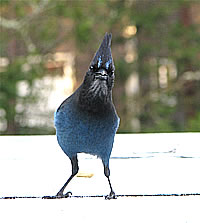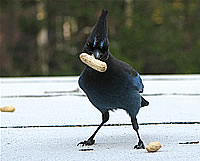





SOUTH-WESTERN OREGON

JAYCONOMICS
It struck me this morning that my garden, with its six bird feeders, is an economic system. It operates with its own inexorable market forces and under certain verities, if now downright economic laws. The Steller's Jays and Western Scrub-jays dominate the garden and affect all parts of the system. Thus I'm describing what is known heretofore as “jayconomics.”
 In jayconomics there are several valuable commodities or
possessions. Certain positions of power are more important than
others. There's a relationship between supply and demand, which
varies depending on the value of the commodity. And there's a
distinct pecking order among economic beings, the various birds.
They range from large corporations, like each jay, to tiny
organisms on the periphery of the system. Though Steller's are
most numerous in the jay-economy in our garden and at our feeders,
they do not dominate in the power structure. The two Scrub-jays
who frequent the area can always drive off the smaller Stellers.
The smaller creatures - chickadees, towhee, juncos - are like the
poor nations of world, having to borrow what they can from the
centers of wealth. “Picking up the scraps” in the technical
economic jargon of our time. Unless I choose to intervene, I'm
simply a force of nature, providing some of the resources on which
the system runs. Think of me as mother nature. Well, OK, think
of me as a government who chooses not to interfere, for better or
worse. So here I am running a free market system, American-style.
That means I take resources from the whole planet and focus them
on my little corner of the world, enabling my birds, corporate
entities and dependent states, to survive or even flourish. It's
starting to sound more like China, isn't it?
In jayconomics there are several valuable commodities or
possessions. Certain positions of power are more important than
others. There's a relationship between supply and demand, which
varies depending on the value of the commodity. And there's a
distinct pecking order among economic beings, the various birds.
They range from large corporations, like each jay, to tiny
organisms on the periphery of the system. Though Steller's are
most numerous in the jay-economy in our garden and at our feeders,
they do not dominate in the power structure. The two Scrub-jays
who frequent the area can always drive off the smaller Stellers.
The smaller creatures - chickadees, towhee, juncos - are like the
poor nations of world, having to borrow what they can from the
centers of wealth. “Picking up the scraps” in the technical
economic jargon of our time. Unless I choose to intervene, I'm
simply a force of nature, providing some of the resources on which
the system runs. Think of me as mother nature. Well, OK, think
of me as a government who chooses not to interfere, for better or
worse. So here I am running a free market system, American-style.
That means I take resources from the whole planet and focus them
on my little corner of the world, enabling my birds, corporate
entities and dependent states, to survive or even flourish. It's
starting to sound more like China, isn't it?
One thing is certain: demand is not dependent on supply, nor vice verse. I can forget to put out a certain resource, and the demand becomes frenzy. I can provide endless resource of one kind or another and the demand stays at a certain level depending on the birds' hunger, greed and the weather. As with the heating oil market, demand for my resources increase in cold weather. It seems to me that demand grows with the potential for supply. How can that be? Well, just like Exxon or Microsoft, the jays can cache cash, or in this case seeds and peanuts. One Steller's Jay, hereafter known as Stella the Jay, has learned to demand more peanuts. Thus she has gotten into the direct subsidy business, sorta like an American corn farmer. Even when times are good, and the sunflowers seeds are plentiful, when regular birdseed falls from the feeders like tax dollars from Congress, even then Stella wants her peanuts. When she gets one, or two, she takes them off to cache them. And immediately returns for more. Interestingly the jays share. When one spots me placing peanuts on the garage roof, a scream goes out and jays within earshot descend. Stella may only demand peanuts in the morning but those nuts will quickly disappear anytime I put them out.
The gray squirrels readily take over the feeders, wasting and wanting at will. They are chary of getting onto the exposed roof for peanuts. That remains the sole turf of the bolder jays.
 There is no end to how much cash, or cache, Stella the Steller
would accumulate. No limit to places where a peanut can be hidden
against a future drought or famine. Perhaps all the peanuts
Georgia can produce, forget the rest of the peanut-eaters in the
world. This is the time-honored capitalist or jayconomic
principle: get everything you can. This peanut principle can be
stated thus: there's no such thing as enough. Stella's a master at
this. When she and a less brave Steller came down onto the garage
roof for the peanuts I thought to manipulate the system. Planning
to do a little Federal Reserve action, I put out two peanuts at
once. I was assuming Stella would grab the larger one and leave
the second for the less capitalized corporation, er, less brazen
jay. Hah, a serious jayconomics lesson was in store for this
bungling government: Stella took the large one as predicted, then
hopped over to the smaller one. She then placed the bigger peanut
next to one foot gobbled down the thinner one, placing it deep in
her throat, then grabbed the large one in her beak again and flew
off to cache BOTH of them. Double profit with nearly the same
effort. A jayconomic bonanza for Stella. Important jayconomic
verity: greed will lead to innovation if the innovation is to the
benefit of said jay. Think of the pharma industry. They will
invent new drugs if they can sell a lot of them and make a profit.
Side effects? Well, that's just the risk you take in jayconomics.
There is no end to how much cash, or cache, Stella the Steller
would accumulate. No limit to places where a peanut can be hidden
against a future drought or famine. Perhaps all the peanuts
Georgia can produce, forget the rest of the peanut-eaters in the
world. This is the time-honored capitalist or jayconomic
principle: get everything you can. This peanut principle can be
stated thus: there's no such thing as enough. Stella's a master at
this. When she and a less brave Steller came down onto the garage
roof for the peanuts I thought to manipulate the system. Planning
to do a little Federal Reserve action, I put out two peanuts at
once. I was assuming Stella would grab the larger one and leave
the second for the less capitalized corporation, er, less brazen
jay. Hah, a serious jayconomics lesson was in store for this
bungling government: Stella took the large one as predicted, then
hopped over to the smaller one. She then placed the bigger peanut
next to one foot gobbled down the thinner one, placing it deep in
her throat, then grabbed the large one in her beak again and flew
off to cache BOTH of them. Double profit with nearly the same
effort. A jayconomic bonanza for Stella. Important jayconomic
verity: greed will lead to innovation if the innovation is to the
benefit of said jay. Think of the pharma industry. They will
invent new drugs if they can sell a lot of them and make a profit.
Side effects? Well, that's just the risk you take in jayconomics.
Since that experiment I've seen Stella picking up and testing peanuts when there are about twenty of them on the roof. She will select those that seem hefty and fit neatly into her two-nut carrying-case. She may drop as many as four peanuts before she selects the right one for her portfolio.
Speaking of risk. I have a friend who is a risk expert and I await his counsel on how to gauge and rationalize the risk-taking of the various entities in my little realm of jayconomics. Clearly the Scrub-jays can dominate and drive off the smaller Stellers. But the Stellers have gained an advantage through innovation of the peanut subsidy, by taking the roof-risk and garnering the peanuts there. Some birds will feed only on the ground, not risking an elevated feeder. Juncos, Mourning Doves and the Spotted Towhee feed only on the resources wasted or dropped from the feeders by the other birds. If there are hawks about they are far more likely to pluck prey from an elevated feeder than take their own risk by swooping down to the ground in our garden which is ringed by fence and trees. A Junco on the ground is only a hop or two from brush and safety at all time. Hedge, not hedge funds, is the junco's jayconomic model.
I expect to learn much more from my study of jayconomics. As long as I don't get sick, go broke or die, the system will continue to operate. In jayconomic terms, or simply American reality, I am likely to do all three in that order at some future date. That's just the way jayconomics, 'er the American markets operate.
TOWHEE.NET: Harry Fuller, 820 NW 19th Street, McMinnville, OR 97128
website@towhee.net